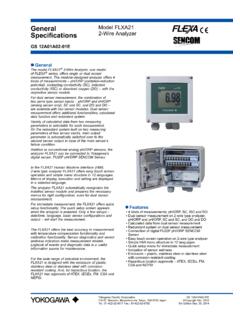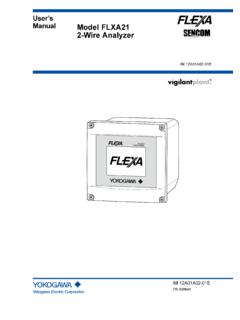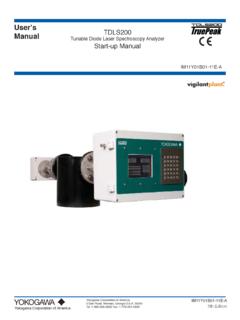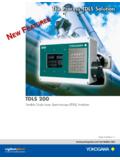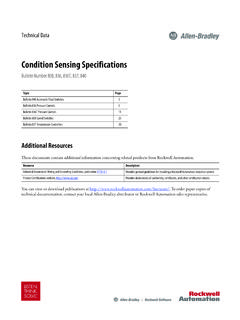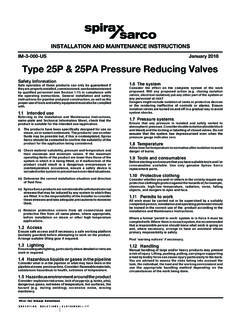Transcription of EJX910 Multivariable Transmitter - Yokogawa Electric
1 EJX910 Multivariable Transmitter13 EJX910 MULTIVARIABLETRANSMITTERITOU Akio *1 MIMURA Shin-ichi *1 KOYAMA Etsutarou *1 ODOHIRA Tetsu *1 NIKKUNI Masaaki *1 MIYAUCHI Tatsuhiko *2We have developed the EJX910 Multivariable Transmitter , an all-in-oneinstrument that integrates the functions of a differential pressure Transmitter , apressure gauge, a thermometer and a flow computer, while featuring highperformance and space-saving design. The Transmitter employs a unique flow ratecalculation method, achieving a mass flow calculation cycle of 100 milliseconds. Byadopting a Reynolds number compensation algorithm, etc., all flow calculationparameters were optimized and a mass flow accuracy rate as high as 1% wasachieved.
2 Furthermore, EJX910 complies with a wide range of primary devices,including orifices, nozzles and venturi tubes, and various types of fluid, includinggeneral fluids, steam tables, and natural gas. Application information, such as theprimary devices and fluid data required for mass flow calculation, is input using theEJXMVTool, a mass flow parameter configuration tool that runs on a PC and isdownloaded to the Transmitter by means of field communication. A field testperformed on a British natural gas test line showed an excellent mass flowmeasurement accuracy of 1%.*1 Industrial Automation Products Business Division*2 Global Service HeadquartersINTRODUCTIONWhen evaluating mass flow rates using a primary devicesuch as an orifice or nozzle in a differential pressureflowmeter in order to make fluid density compensations, theupstream pressure (static pressure ) and fluid temperature aremeasured in addition to the output of a regular differentialpressure Transmitter .
3 In the past in such cases, a differentialpressure Transmitter , a pressure Transmitter , a temperatureconverter and a flow computer were all separately required. TheDPharp EJX series of differential pressure transmitters developedby Yokogawa in 2004, can simultaneously measure bothdifferential pressure and static pressure using an advanced formof silicon resonant sensors that comprise the multi-sensingfunction. Recently, we have developed the EJX910 multivariabletransmitter as a new model that incorporates this series functionsto full advantage. The EJX910 integrates the functions of adifferential pressure gauge, a pressure gauge, a thermometer, anda flow computer into a single instrument, thereby achieving highspace efficiency and Reynolds number compensation algorithm and othermeans have been adopted for the mass flow rate calculation ofthis Transmitter to optimize all flow rate calculation parametersand achieve high-precision mass flow rate measurement.
4 In thispaper, we will focus on the functions related to mass flow ratecalculation, one of the features a Multivariable Transmitter has tooffer. Figure 1 shows an external view of the 1 External View of EJX91014 Yokogawa Technical Report English Edition, No. 42 (2006)PRODUCT FEATURESThe EJX910 Multivariable Transmitter serves as a differentialpressure gauge, a pressure gauge, and a thermometer (with anexternal temperature sensor). In addition to thismultifunctionality, the fluid density compensation functionprovided by the Transmitter itself and the PC-installedEJXMVTool s mass flow parameter configuration tool enablehigh-speed, high-precision mass flow rate measurement. TheEJX910 supports a number of flow rate standards and a variety offluid types as target applications.
5 Moreover, the EJX910 can beapplied to integrated flow rate measurement and variousdiagnoses that use many process variables (differential pressure ,static pressure , temperature, etc.). MASS FLOW RATE CALCULATIONF igure 2 shows an example of measuring mass flow rates fromorifices and temperature sensors installed in a process. The EJX910measures the difference between the upstream and downstreampressures of the orifice placed in the process, the upstream staticpressure and the fluid temperature. Then the Transmitter calculatesthe mass flow rate from these measured 3 shows a configuration of a mass flow ratemeasurement system. Application information necessary for flowrate calculations (primary device and fluid information) is inputusing the EJXMVTool mass flow parameter configuration toolrunning on a PC.
6 This information is then converted intoparameters that can be perceived by the Transmitter anddownloaded to the Transmitter by means of field 4 shows a block diagram of a mass flow ratemeasurement system comprising the EJX910 and pressure , static pressure and temperature measured bythe EJX910 can be directly output as process variables. The systemperforms fluid density compensation calculations according to thefollowing equation to determine the mass flow this purpose the system employs a unique method ofcalculation that minimizes the Transmitter s calculation load, andachieves a flow rate calculation cycle of 100 milliseconds. In asimplified method of flow rate calculation, the parameters inEquation (1) are treated as fixed values, resulting in large massflow rate calculation errors as shown in Figure 5.
7 The EJX910performs optimized calculations in real time using dynamicallychanging parameters, thereby realizing a high flow rate accuracyof 1%. More specifically, Reynolds number corrections are madeto the discharge coefficient (C) according to changing measuredvalues. The gas expansion correction factor ( ) is correctedagainst the effects of adiabatic expansion of gases. In addition,the fluid density ( 1) is corrected for static pressure andtemperature 2 Example of Mass Flow Rate Measurement Using Orifice124241 PdCQm =Mass flow rateDischarge coefficientBeta ratio (d/D)Bore of primary devicePipe inner diameterGas expansion factorDifferential pressureFluid density::::::::whereDdC Qm (1)P 1 Figure 3 Mass Flow Rate Measurement System ConfigurationEJX910 Multivariable TransmitterDifferential pressure , static pressureMass flow rateTemperatureDifferential pressure , static pressure , temperatureFluidTemperature sensorPCEJXMVTool mass flow parameter configuration toolApplication information(primary device and fluid information)DownloadEJX910 Multivariable transmitterTemperature sensorMass flow rateFigure 4 Mass Flow Rate Measurement Block DiagramEJXMVToolEJX910 Physical property database(general fluids, steam tables, natural gases)
8 Primary device informationFlow rate calculation standardsSelection of fluid type and operating conditionsFlow rate calculation parametersSensor inputOutputOutputOptimizationDifferentia l pressureStatic pressureTemperatureFlow rate calculation parametersFlow rate calculationEJX910 Multivariable Transmitter15 SUPPORTED APPLICATIONSThe primary devices that the Multivariable Transmitter iscompatible with, , orifices, nozzles and venturi tubes, complywith a number of flow rate standards. In addition, a fixed mode isavailable to set desired values to the discharge coefficient and thegas expansion correction factor. The Transmitter can handle awide variety of fluid types as described below:(1) General fluids (gases and liquids)The Transmitter supports 12 types of general fluids andemploys the DIPPR physical property database widely usedaround the world.
9 (2) Steam tablesThe Transmitter supports IAPWS-IF97 Water and Steam(1997), the standard for steam tables used in each country( , JSME and ASME).(3) Natural gasesThe Transmitter complies with the following typical naturalgas calculation standards:AGA8 Detail Characterization MethodGross Characterization Method 1 Gross Characterization Method 2 ISO 12213: 1997 First edition (Dec. 1, 1997)Part 2: molar-composition analysisPart 3: physical properties(4) Custom fluidsUser-maintained physical property values can beincorporated in the OF EJXMVTOOL MASS FLOWPARAMETER CONFIGURATION TOOLF igure 6 shows the structure of the EJXMVTool mass flowparameter configuration tool used to set mass flow rateapplication information.
10 (1) Flow rate parameter configuration functionThis function comprises interactive graphic screens used toconfigure the flow rate calculation parameters shown inEquation (1), including application information such asprimary devices and fluid types. Parameters can beconfigured easily as this function automatically converts theparameters to the Transmitter s format.(2) Flow rate parameter management functionThis function saves flow rate parameters to a file, uploads anddownloads these files to and from the Transmitter , obtainsresults of parameter calculation by the Transmitter , andoutputs reports.(3) General-purpose parameter management functionThis function sets general-purpose parameters such as rangesand units.

